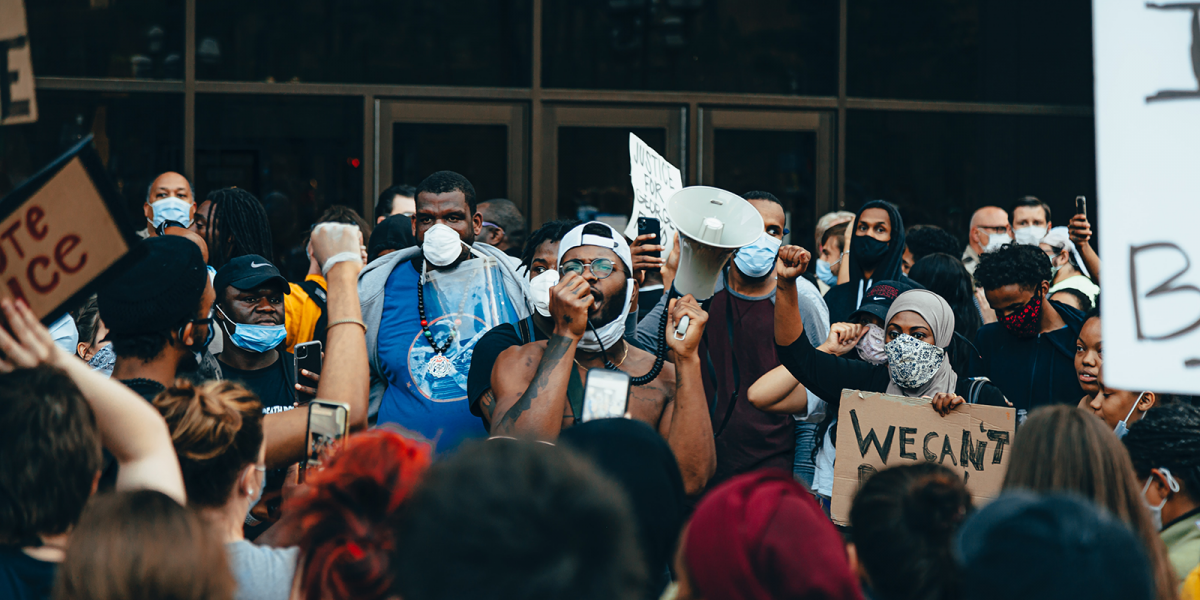
I can take no credit for the ideas about institutional change reflected here; rather I credit The Massey Dialogues: on Anti-Black Racism with Dr. Alissa Trotz, Dr. Lisa Robinson, and MBA Candidate Frank Otabor for opening my eyes to the reality that change is possible and that the road to change has been here all along. The Massey talk is available at: https://www.youtube.com/watch?v=qjpsyCebnpI
Two weeks after police murdered George Floyd, I received an email with the subject line: “Urgent faculty meeting: anti-Black racism.” The purpose of the hastily called Zoom meeting was for the Dean to share with us, the faculty, feedback recently received from our students regarding the school’s unacceptable attempts at addressing anti-Black and anti-Indigenous racism. As it turns out, we had received a failing grade.
Later, we learned from the results of a survey our students conducted of their peers (“Diversity and Inclusion Experiences at the Faculty”) that fewer than 30 per cent of our students feel supported by their peers and professors, fewer than 4 per cent feel we have enough courses on Black, Indigenous, People of Color (BIPOC), Lesbian, Gay, Bisexual, Transgender, Queer or Questioning and Two-Spirit (LGBTQ2S), and disabled experiences, and fewer than 1 per cent feel that “classroom conversations on colonization, use of racial language, and accessibility needs are facilitated properly.” The results of the survey recommended mandatory anti-oppression training for all faculty and staff.
My initial reactions to this information were shame, sadness, and a profound sense of failure. I know that many of my colleagues and I have been working hard in recent years to decolonize our curricula to fulfil and honour the Truth and Reconcilliation Commission’s recommendations for educators in institutions of higher education. We have also been correcting our spoken and written language to create and model a gender-neutral and inclusive environment within our classes.
This summer, in addition to adapting our courses to an online environment in response to the COVID-19 pandemic, we are reflecting on our positionality as university teachers during this historic moment, while searching for ways we can eliminate anti-Black and anti-Indigenous racism on campus, in our classes, and as part of a broader social project. Come this fall, many of the young people currently protesting, marching, and posting their outrage and, for some, a new-found political awareness on social media, will be sitting (virtually) in front of us, demanding and deserving a response.
Systemic frustration
A couple of days of reflection following our meeting with the Dean, I realized that I also felt extremely frustrated. Frustrated at what has come to feel like a predictable response on the part of the administration whenever an oppressed community rises up and surfaces the disconnect between institutional discourses and the reality of their lived experiences on and off-campus. First, the institution produces official statements that reiterate the university’s commitment to its mission, specifically,
[the university] is dedicated to fostering an academic community in which the learning and scholarship of every member may flourish, with vigilant protection for individual human rights, and a resolute commitment to the principles of equal opportunity, equity and justice.
Second, it implements sensitivity and cultural competency training for all employees. The reality is, however, that the heavy lifting and invisible emotional labour required to communicate messages consistent with the institution’s mission falls to those of us on the frontlines, particularly, those of us who teach.
Yes, we are the people with whom students are most intimately and regularly involved. Their concerns and fears and anger and frustrations are a reality for us each and every time we walk into a classroom, lecture hall, seminar room, or meet with students one-on-one in our offices. Our relationships are up close and personal. Not surprisingly, perhaps, is the irony that it is this very proximity to our students that make us, as frontline faculty and staff: (1) often the first workers that students point to when historical injustices surface in the wider world and they experience their institution as complicit; and (2) discursively valuable as ticked boxes for university administrations through our mandated attendance at sensitivity training that appears within weeks of an uprising.
My frustration is not with the students, their feedback or their recommendations—these are valid and deserving of action. Rather, my frustration arises from what has come to feel like a pattern of devolving all responsibility for the institution’s discourses of inclusivity, equity, and justice down to those of us on the frontlines: an approach that absolves the central administration of responsibility, obscures more than it illuminates, does not stand up to critical scrutiny, and demands a level of cognitive dissonance that is exhausting, demoralizing, and cynical-making.
As a rapid policy intervention, these mandated trainings can be read as attempts by senior administrators to project an aura of sensitivity and to gesture at the institution’s mission, while, at a fundamental level, allowing business to go on as usual. Discursively, they effectively foreclose on more systemic change by diverting attention away from the system and placing it on the individual faculty or staff member attending the session. Curiously, this is exactly what is unfolding in response to movements opposing anti-Black and anti-Indigenous racism. The university is providing a series of institution-wide anti-racism trainings for all faculty and staff—and it is to be commended for what looks like an excellent series of trainings—but nowhere is there any suggestion of plans for a paradigm shift.
Shifting the paradigm
Meaningful change will not come if efforts are limited only to re-educating instructors (and other staff), although that is an essential component. Real change can only come when those senior administrators occupying the highest positions of power in our institutions decide to dismantle the racist and colonialist systems upon which our universities are founded. Racism is systemic, it is historic, it is tightly woven throughout our social fabric, and built directly into our bureaucracies. Thus, a path forward solution will only be found if those with the power to allocate our institutions’ finite resources adopt an action-oriented agenda committed to dismantling and defunding all those initiatives and bureaucracies that serve to fortify the current structure.
This work must include working with the campus community to critically assess the efficacy of existing programs whose specific mandate is to support anti-racist initiatives and then, based on that consultation, defund or cancel those that are deemed ineffective. The University of Toronto’s Anti-Racism and Cultural Diversity Office is a case in point. It does good work, no doubt, but with a history dating back to 1991, when a Special Committee on Race Relations and Anti-Racism Initiatives was established, the university’s 2017-18 report on employment equity, diversity, and inclusion showed that only 2 per cent of faculty and librarians and 6 per cent of staff identified as Black. Further, among the 2 per cent who are academics, important questions remain regarding their concentration in faculties and research areas where diversity issues like social justice, equity, and racialization are not the focus of study and teaching. And this is all we have to show after almost 30 years of the Anti-Racism and Cultural Diversity Office’s operations?
These newly liberated resources (money, talent, space) can then be invested into the university’s renewed efforts to ensure equal opportunity, equity, justice and a learning and scholarly environment where all can flourish. Senior administrators won’t have to look far for worthy yet under-resourced recipients. Already in existence is an elaborate infrastructure that has been doing the work to counter anti-Black racism for decades through old and new networks (e.g., the Black Faculty Network), knowledge centres (i.e., Canada Research Chairs and scholars of African studies, Caribbean studies, and Black Diaspora Cultural Studies), and student associations (e.g., the Black Student Association, the Black Liberation Collective), and they have made a difference!
For instance, there was nothing inevitable about the twenty-four Black students entering their first year of medical school this fall. What is absent in any of the media coverage are the years of work—invisible to the outside world—of Black faculty and volunteers from that community who have been painstakingly laying down, stone by stone, pathways to student success that trackback to 1970 and the establishment of the Transitional Year Programme (a university-prep program for working-class and racialized youths and adults without the formal requirements to enter university). Yet, nowhere in the university’s communications of this milestone is that work acknowledged. I learned last week that there’s a name for this, it’s called the “minority tax.”
Structural change will also provide opportunities to open up new spaces for innovation and creativity. What if the University of Toronto established a Black Canadian Studies Institute funded to the same degree as its School of Cities? That’s an idea that Alissa Trotz, the Director of U of T’s Women & Gender Studies Institute and Professor of Caribbean Studies, muses about in the Massey Dialogues: on Anti-Black Racism. Or why not provide sufficient funding to support the development of a new global curricula for faculty and students that will dispel our epistemologies of ignorance as theorized by Charles Mill in the Racial Contract.
Of course, systemic and structural change of this magnitude demands a new generation of visionary and representative leaders who can be handed the reins of power and inspire us all to the next level. And they are here, on our campuses, in our faculties, and across the country. You can see them in the depth and breadth of a long-established scholarship on the Black experience in higher education, as members of the Black Canadian Studies Association, in the appointees to Black faculty working groups, and among the small number who occupy Associate Dean and Director portfolios.
Change that’s more than rhetoric
Our Black and Indigenous colleagues have the ability, the knowledge, and a vision of what to do and how to start. But they can’t do this work without resources and support. As allies from all corners and levels of the university, we can provide support and can do this work with them.
Yes, we have a lot of work ahead of us, not the least of which is critically reflecting on the meaning of our white privilege (if we are white and, according to the university’s most recent employment equity report, 76 per cent of us at U of T are) and educating ourselves about anti-Black and anti-Indigenous racism, the movements growing in resistance, and the contributions to racial justice and equity our Black and Indigenous colleagues have made on campus.
However, unless senior university administrators find the courage and political will to shift the balance of power and commit the resources necessary for systemic change, all that will result from faculty and staff training, discussing, researching, and reporting is just more window-dressing, draping the university in empty rhetoric.
Siobhan Stevenson is an associate professor in the Faculty of Information at the University of Toronto.










